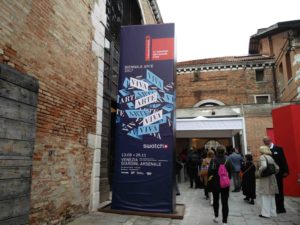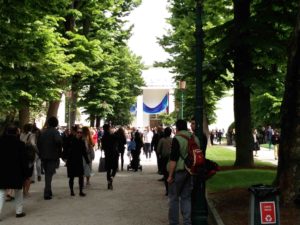On Saturday the 13th of May the 57th Biennale of Venice opened. The artistic director Christine Macel united 120 artists from 51 countries for the main exhibition under the title “VIVA ARTE VIVA” subdivided in nine sections. Moreover, there are 86 National Participations in the historic Pavilions at the Giardini, at the Arsenale and in the city centre of Venice. In addition, there are 23 official Collateral Events and many unofficial ones.
“VIVA ARTE VIVA” starts in the Central Pavilion and the Stirling Pavilion at the Giardini with the two sections “Artists and Books” and “Joys and Fears” followed by the seven others in the Arsenal halls. John Latham deformed books by combustion and spray painting; Geng Jianyi emptied the books of their potential by soaking them in ink or paint. Whereas Liu Ye depicted books, inspired by volumes collected during the Cultural Revolution in China and Irma Blank wrote new books without letters and words.
This thread is picked up in the Arsenale by Maria Lai, who stitched wordless books. Strings are playing as well a role in the work by Lee Mingwei. The red line of paper and textile based oeuvres runs through the exhibition and culminates in extensive installations by Leonor Antunes, Ernesto Neto and Sheila Hicks. These site-specific works really exploit the wonderful huge space of the Arsenale.
 All the nine Pavilions from “Artists and Books” to the “Pavilion of Time and Infinity” are interwoven, since there is – in contrast to the traditional national ones – no physical separation between them. In total, it is a mixed show with all kinds of artistic disciplines, from performance, video, installation, to the more traditional sculpture and panel painting.
All the nine Pavilions from “Artists and Books” to the “Pavilion of Time and Infinity” are interwoven, since there is – in contrast to the traditional national ones – no physical separation between them. In total, it is a mixed show with all kinds of artistic disciplines, from performance, video, installation, to the more traditional sculpture and panel painting.
Even though the national contributions are in general divided by their architecture, Slovenia Georgia, Kosovo and Croatia are sheltered in one huge hall of the Arsenal and are standing almost seamlessly besides each other. Interaction between nations also exists in the Giardini: In the heat of the summer, the waiting visitor in front of the German Pavilion will be thankful for the cooling water splashes carried over by the wind from the Canadian Pavilion. Several national participations and collateral events are located outside two main exhibition areas. In consequence, they are even more interlaced to the city and Venice becomes a huge playground for art during the six months of the Biennale.
Here some impressions:
Pavilion of Artists and Books
Pavilion of the Common
Pavilion of the Earth
Pavilion of Tradition
Pavilion of Shamans
Dionysian Pavilion
Pavilion of Colors
Pavilion of Time and Infinity
The National Pavilions



















































